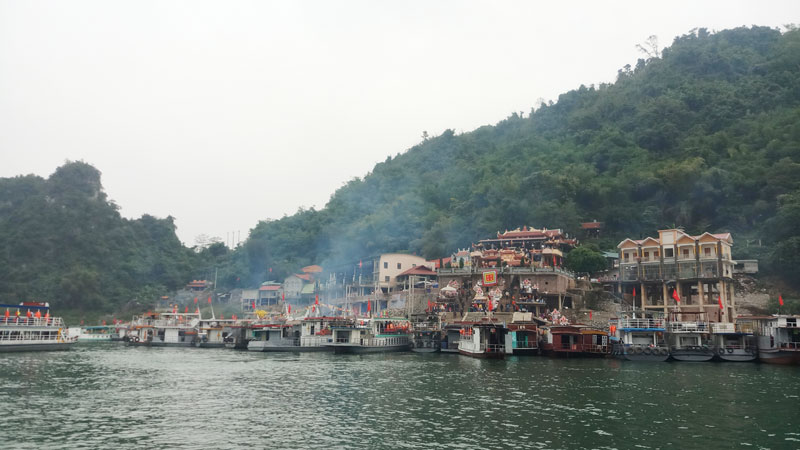
(HBO) – With the poetic beauty described as a miniature Ha Long Bay, Hoa Binh Lake and the relic site of Bo Temple in Thung Nai commune (Cao Phong district) and Vay Nua commune (Da Bac district) offer visitors a chance to be engulfed in nature with countless islets on the vast lake.
On the banks of this lake, there are villages of Muong and
Dao people where the traditional cultural identities of the ethnic groups are
still preserved today. Particularly, since the Prime Minister approved the
building of Hoa Binh Lake into a national tourist site, the place has received
investment to become an ecological and spiritual tourism area that has proved
increasingly attractive to travellers. Among destinations in this area, Bo
Temple stands out amid the grandeur landscape.

Bo Temple stands out amid the grandeur landscape.
In the spring, Bo Temple welcomes thousands of
visitors each day.
People pray for wealth, health and safety in the New
Year.
Grilled fish of the Da River is a famous delicacy that
every visitor to Bo Temple wants to taste and buy.
.
Boats carry visitors on sightseeing tours of the lake.
Thanks to its beauty, Hoa Binh Lake is described as a
miniature Ha Long Bay.
Bo Temple, also known as the Temple of the Lord
of Bo Waterfall, is associated with the story about King Le Loi’s trip to put
down a revolt in the spring of 1431. Legend has it that when the king’s troops
arrived in the Bo Waterfall area, they received support from locals, including
Dinh Thi Van – a Muong ethnic woman in the land which is now Vay Nua commune.
She called on other people to donate food to the troops and took them by boat to
quell the rebellion. Due to her great contributions, after Van passed away,
King Le Loi ordered locals to build a temple dedicated to her in the Bo
Waterfall area, and it has become a popular place of worship of local
residents. Bo Temple comprises Trinh and Chau temples and features 38 statues
of all sizes.
Every year, the Bo Temple festival lasts from
the second day of the first lunar month through the third lunar month. Thanks
to the imposing landscape and the temple’s sacredness, the site welcomes
thousands of visitors coming from far and wide each day in the spring to pray
for health, safety and happiness for each family and peace and tranquility of
soul in the New Year./.
A diverse chain of eco-tourism and resort destinations concentrated in Hoa Binh city and the districts of Tan Lac, Da Bac, and Luong Son… Along with the launch of several key high-quality resort tourism projects, these developments have reshaped the landscape and enhanced the appeal of Hoa Binh as a travel destination.
Boasting diverse terrain, a mild climate, and rich natural resources, Cao Phong district is increasingly asserting its place on Vietnam’s tourism map, attracting both domestic and foreign visitors. The district is renowned for its stunning landscapes, majestic mountains, a crystal-clear hydropower lake, and the unique cultural identity of local ethnic groups.
With its pristine landscapes, unique cultural heritage of Muong ethnic minority, and an expanding range of visitor experiences, Tan Lac district of Hoa Binh has fast become a captivating destination for both domestic and international tourists.
Until now, Sung village in Cao Son commune, Da Bac district remains the only Dao ethnic community in Hoa Binh province to develop a community-based tourism model. Beyond its untouched natural landscapes, cultural identity serves as the cornerstone attraction for visitors.
Alongside the diverse cultural identities of the Kinh, Muong, Tay, Thai, Dao, and Mong ethnic people, Hoa Binh province is also renowned as the "capital" of the northwestern Vietnamese cuisine, offering unique and distinctive dishes. At festivals, during Lunar New Year (Tet), or on significant family or community occasions, special dishes are prepared, leaving a lasting impression on visitors.
A Phong Linh (Yellow Tabebuia) flower garden in Thang village, Thach Yen commune, Cao Phong district is currently in full bloom, drawing a large number of visitors.









